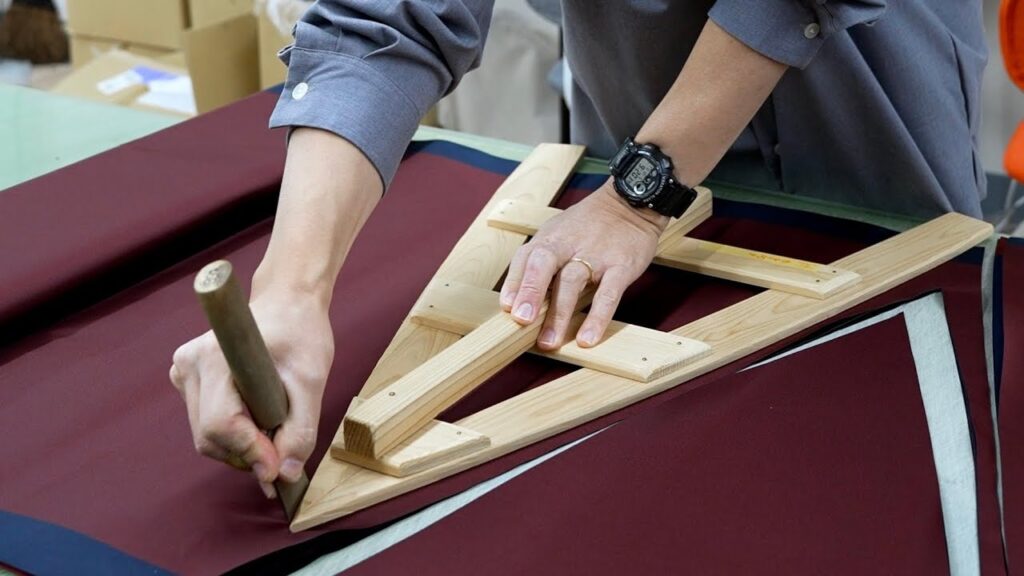【小宮商店】
1930年創業の洋傘専門店。
機械化の現代でも、そのほとんどの工程が手作業である傘作りを熟練の職人たちが手がける。
その一部が東京都の伝統工芸品に選出され、携わった職人も伝統工芸士として認定されている。
気に入っていただけたら
ぜひいいねやコメント、チャンネル登録をお願い致します!
みなさんのご意見をもとに、素晴らしいチャンネル作りを目指していきます!
⛱小宮商店
https://www.komiyakasa.jp/
📍 東京都中央区東日本橋3丁目9−7
https://maps.app.goo.gl/7Kkf5WFdURvRSdnn7
#傘
#洋傘
#プロセス
#職人技
This video has subtitles in multiple languages so that people around the world can enjoy it, and the subtitles are automatically played. This time, we interviewed Komiya Shoten, a Western umbrella specialty store that has been in business for over 90 years.
The technique, which has been passed down from generation to generation since 1930, is even recognized as a traditional craft. I will show you the whole story. First, cut the fabric. Cut the fabric into triangles according to the wooden pattern. This fabric is called a koma.
It may seem like a simple process, but it is an important process that determines the finished product of the umbrella. Move the skin knife in your hand in a steady rhythm.
It is a true craftsmanship that pays attention to everything from the angle of insertion of the blade, the amount of force applied, and the expression of the fabric. The wooden mold has a gentle curve, and this curve creates a beautiful umbrella shape.
It is one of the important tools for making umbrellas, so much so that it has become the symbol of Komiya Shoten. Frame inspection to check each piece of fabric after cutting. While looking through the fabric, check for scratches and frayed threads. Continue sewing the frames together.
Although it is sewn together quickly, it is a process that requires adjustment down to the millimeter. This work is called middle stitching. The umbrella cover is now complete. Next, prepare the fabric to be sewn onto the umbrella bone.
Place the mold on top of the dough and pound it with a mallet to prepare the parts called tengami. It seems that this mold and wood have been used for over 60 years. Attach the parts from earlier to the bone.
The joint part of the umbrella is called the dowel. Did you all know? Sew the previous parts one by one to this joint. When the fabric and bones come into close contact, it prevents dirt and abrasion. It seems that you can use it as an umbrella without any problems, but
This is a way to ensure that you can continue using a good item for a long time. You can feel the craftsman’s dedication and passion in each and every work. In the same way, we will attach the parts to the potter’s wheel.
What part of the umbrella is the potter’s wheel? The answer is after this. Sew the fabric into a tube shape. Attach the cloth from earlier to the potter’s wheel. The potter’s wheel was the part that pushed up the bones when opening the umbrella.
It is sewn by hand in the same way as dowels. The potter’s wheel winding protects your fingers when opening and closing, and at the same time looks beautiful, and takes time to be carefully installed.
The craftsman’s passion for details such as dowel wrapping and potter’s wheel wrapping has been passed down and continues as a tradition. The Japanese spirit of caring for others is rooted in the making of umbrellas. Now it’s time to attach the fabric to the bones. Put the cover on and sew the ceiling together.
Next, sew each bone and the edge of the cover together. We don’t just sew, we also adjust the tension of the umbrella as we sew. Finally, the familiar shape of an umbrella appeared. Next, sew the cover and bone together with thread. This is also an important process that determines the finished product.
After sewing, I ironed each piece and completed installing the cover. Next time, let’s make a string. This is the string used to close and tie up the umbrella. In no time at all, the cloth is sewn into a string. Attach the button to the string. The tie string is now complete.
We will attach it to the cover. Now it’s time to finish the work. Attach an additional cover to the tip of the umbrella to prevent rain from leaking. Insert the circular part called the chrysanthemum and the waterproof packing, and attach the conical fitting from above. This metal fitting is called a jingasa.
Jinkasa is fixed with studs to prevent it from coming off. Finally, we will attach the hands. Wrap the thread over the bond to securely secure your hand. Choosing an umbrella will be even more fun by having a wide variety on hand and combining it with your favorite fabric.
If you are interested, please stop by the store. In this way, one umbrella was completed by the hands of a craftsman. Umbrellas are made by hand by craftsmen, using the same manufacturing methods as in those days. What did you think of the traditional techniques that have been passed down from generation to generation?
Thank you for watching.


2 Comments
貴重な動画、傘作るところ初めて見た。一つひとつサラッとこなしてるけど、技術が無いと到底無理だよね。。すごい
東京郊外に青梅傘が有ったんですが、作る人も後継者も居なくなり無くなりました!お寺さんで見せて頂き、番傘のような傘でした。